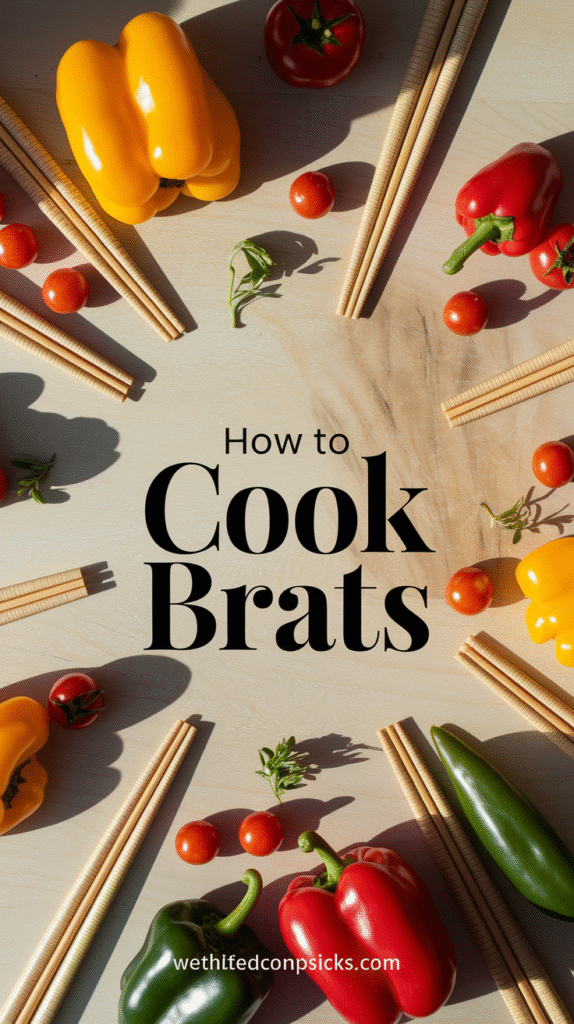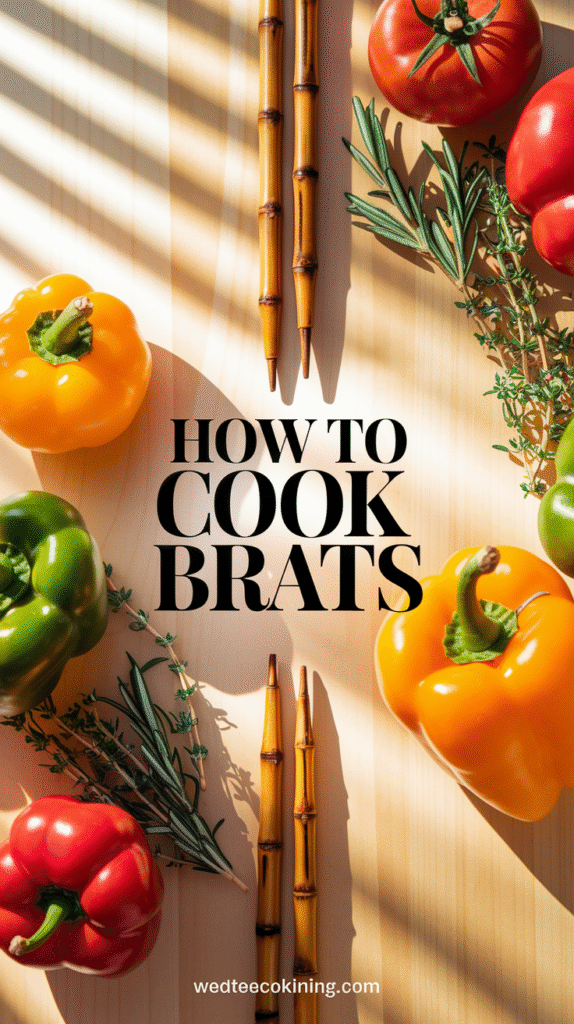Cooking brats can elevate your culinary skills and provide a delicious meal for any occasion. Whether you’re planning a backyard barbecue or a cozy dinner at home, mastering the art of grilling sausages can make all the difference. Here’s a comprehensive guide on how to cook brats perfectly.
Choosing Your Brats
Before you even think about cooking, you need to select the right brats. Here are some popular types to consider:
- Traditional German Bratwurst – Known for its mild flavor.
- Spicy Bratwurst – Offers a kick with spices.
- Beer Bratwurst – Infused with beer for enhanced taste.
- Bratwurst with Cheese – Contains cheese for creaminess and flavor.
When shopping, look for high-quality sausages made from pork, beef, or a mix. Check the ingredients for any unnecessary fillers.
Preparation Steps for Cooking Brats
Preparation is key to ensure your brats turn out juicy and flavorful. Follow these steps:
- Remove the Brats from the Packaging – Let them sit at room temperature for about 20 minutes.
- Prick the Brats Gently – Use a fork to poke a few holes; this prevents them from bursting while cooking.
- Choose Your Cooking Liquid – Soaking brats in beer, broth, or water for 30 minutes adds flavor.
Cooking Techniques
Now that you have your brats prepped, it’s time to cook them. Here are several effective techniques for grilling:
Grilling on a Gas Grill
Grilling on a gas grill is convenient and straightforward. Follow these tips:
- Preheat your grill to medium heat.
- Add your brats to the grill, turning occasionally for even cooking.
- Cook for about 15-20 minutes or until they reach an internal temperature of 160°F (70°C).
Grilling on a Charcoal Grill
If you prefer charcoal, the smoky flavor adds another layer of taste. Here’s how:
- Light your charcoal and wait for it to ash over, achieving a hot, even heat.
- Place your brats over direct heat, moving them to indirect heat if they cook too quickly.
- Cook for 15-20 minutes, checking for doneness frequently.
Stovetop Cooking
Cooking brats on the stovetop is simple and effective, especially in poor weather. Here’s the procedure:
- Heat a skillet over medium heat and add a few tablespoons of oil.
- Once the oil is hot, add the brats and cook for 10-12 minutes, turning frequently.
- Add a splash of your cooking liquid for extra moisture and flavor.
Serving Suggestions
Once your brats are ready, it’s time to serve! Here are some popular pairing ideas:
- Serve them in a fresh bun with mustard and sauerkraut.
- Accompany with grilled veggies like peppers and onions.
- Try a side of potato salad or coleslaw for a complete meal.
Tips for Delicious Brats
To ensure a perfect cook every time, keep these additional tips in mind:
- Always use a meat thermometer for accurate temperature readings.
- Let your brats rest for a few minutes after cooking to retain juices.
- Experiment with different marinades and seasoning for unique flavors.
For more information on brats and recipes, visit Brats and Brews or check out The Bratwurst Company for some delicious options.
Cooking brats is an enjoyable and rewarding experience. With these techniques and tips, you’ll impress your friends and family with deliciously cooked sausages at your next gathering.
Pairing Suggestions: Best Sides and Sauces for Bratwurst
When it comes to bratwurst, the right sides and sauces can elevate this delicious sausage to new heights. Whether you’re grilling in your backyard or having a cozy dinner at home, pairing your brats thoughtfully will leave everyone satisfied. Here are some fantastic suggestions to enhance your bratwurst experience.
Classic German Sides
Given bratwurst’s German roots, traditional sides often pair perfectly. Here are some favorites:
- German Potato Salad: This warm salad with a tangy vinegar dressing complements the savory flavors of bratwurst.
- Sauerkraut: The fermented cabbage provides a crunchy, sour contrast that balances the richness of the sausage.
- Red Cabbage: Sweet and slightly tangy, this dish adds color and freshness to your plate.
- Spätzle: Consider this soft noodle as a filling option that soaks up the juices of the bratwurst.
Fresh Salads
If you’re looking for something lighter, salads are an excellent choice. Here are some ideas:
- Arugula and Apple Salad: The peppery arugula paired with sweet apples offers a refreshing crunch.
- Coleslaw: A creamy or vinegar-based coleslaw can add texture and a nice cool element to the meal.
- Greek Salad: Tomatoes, cucumber, olives, and feta can add a Mediterranean twist that contrasts nicely with the brats.
Hearty Sides
If you want to turn your bratwurst into a full meal, these hearty options will fill you up:
- Baked Beans: The sweetness of baked beans can complement the saltiness of the bratwurst nicely.
- Macaroni and Cheese: This comfort food adds creaminess and richness to your plate, making for an indulgent treat.
- Grilled Vegetables: Seasonal veggies like zucchini, bell peppers, and corn bring a smoky flavor and nutrition.
Flavorful Sauces
When it comes to sauces, think beyond the standard mustard. Here are some delicious options:
- Spicy Brown Mustard: A classic choice for bratwurst, its zesty kick matches the sausage beautifully.
- Honey Mustard: For those who enjoy a sweet twist, honey mustard pairs perfectly with the savory flavor of brats.
- BBQ Sauce: For a smoky and sweet flavor, BBQ sauce can be a great addition, especially if grilled.
- Beer Cheese Sauce: A creamy sauce made with cheese and beer adds richness and an indulgent feel to your brats.
- Chili Sauce: The heat and flavor of chili sauce can give your brats a whole new dimension.
Picking the Perfect Bread
The vessel in which you serve your brat can make a significant difference. A few popular choices are:
- Brat Buns: Soft, slightly sweet, and designed to hold bratwurst well, these are a must.
- Pretzel Buns: For a gourmet touch, consider serving brats on warm pretzel buns – a delicious treat!
- Crusty Bread Rolls: If you’re after something a bit more robust, crusty rolls can provide a satisfying crunch.
Remember to garnish your brats with fresh toppings to add flavor and texture. Options like diced onions, sauerkraut, or jalapeños can be fun! Everyone loves customizing their meal.
As you prepare for your bratwurst feast, consider these pairings for a well-rounded and fulfilling meal experience. Whether it’s a backyard barbecue or a weeknight dinner, these sides and sauces will impress your guests and satisfy your cravings. For even more ideas, check out Simply Recipes or Food Network for recipes and cooking tips.
Explore the rich flavors and versatility that come from pairing bratwurst with the right sides and sauces. Enjoy your culinary adventure!
The History of Bratwurst: Origins and Cultural Significance
Bratwurst, a beloved German sausage, boasts a rich history that stretches back centuries. Originating from various regions in Germany, bratwursts have become a culinary staple, known for their delicious flavor and cultural significance. The evolution of this flavorful sausage tells a story of tradition, regional pride, and the celebration of community gatherings.
The precise origins of bratwurst are hard to pinpoint. Historical records suggest that the first instances of bratwursts appeared in the 14th century. Each region in Germany developed its unique twist on this sausage, using specific blends of meats, spices, and preparation methods. The three primary regions known for their bratwurst are:
- Thuringia: This area is famous for its first recorded bratwurst in 1404. Thuringian bratwursts typically contain a mix of pork, beef, and spices like marjoram and nutmeg.
- Nuremberg: Nuremberger bratwursts are smaller and often made with pure pork, flavored with ginger and pepper. In 2003, they received official protected status under EU law.
- Swabia: Swabian bratwursts often incorporate veal and are milder in flavor, appealing to various palates.
Over the centuries, bratwurst emerged as a staple at German festivals, markets, and public gatherings. The sausage is often associated with Oktoberfest, where it pairs perfectly with local beers, creating an enticing combination enjoyed by many. Its presence at festivals is far more than just a culinary tradition; it fosters community spirit and brings people together to celebrate and enjoy each other’s company.
The cultural significance of bratwurst goes beyond its delicious taste. It’s a symbol of German craftsmanship and pride. Many families pass down recipes for bratwurst, ensuring that each generation understands and cherishes this culinary tradition. The art of making bratwurst is not only about ingredients but also about the method—grilling, boiling, or pan-frying each bring out different flavors and textures in the sausage.
In modern times, bratwurst has transcended its German origins and found a place in the hearts of many food lovers around the world. The sausage is now a popular item at cookouts, sporting events, and outdoor festivals, particularly in the United States. Many cities host bratwurst festivals that celebrate this delicious food, showcasing various recipes and cooking techniques.
To cook bratwurst perfectly, consider the following methods:
- Grilling: Preheat your grill to medium heat. Grill bratwurst for about 4-6 minutes on each side. Be attentive to avoid burning.
- Boiling: Boil bratwurst in a pot of water or beer. This method ensures they stay juicy and flavorful. Simmer for about 20 minutes before grilling for a crispy texture.
- Pan-frying: In a skillet, add a bit of oil and cook over medium heat for 6-8 minutes, turning frequently until browned and cooked through.
Traditionally served with sauerkraut, mustard, and freshly baked bread, bratwurst remains a beloved dish for many. Its versatility means you can experiment with toppings like caramelized onions, peppers, or even salsas, adding a modern twist to this classic dish.
As bratwurst continues to gain popularity, some artisanal producers have started to craft unique variations that incorporate diverse ingredients. For instance, gourmet bratwursts might use apple, cheese, or spices from various cultures, demonstrating the ongoing evolution of this traditional sausage.
If you want to dive deeper into the history and cultural significance of bratwurst, consider checking out resources like Bavaria and Food Network. These sites explore the different facets of bratwurst and offer recipes that you can try at home.
Bratwurst stands as a significant culinary icon, embodying the rich heritage of German culture while uniting people through food. Its enduring popularity is a testament to the timeless joy that sausages can bring to our tables.
Bratwurst Variations: Exploring Regional Flavors Across the United States
Bratwurst, often simply referred to as “brats,” have become a beloved staple in American cuisine, especially in regions influenced by German settlers. While the classic bratwurst is made from pork and seasoned with spices, regional variations across the United States showcase unique flavors and ingredients that reflect local tastes and traditions. Here’s a closer look at some of the most fascinating bratwurst variations found nationwide.
Wisconsin: The Bratwurst Capital
Wisconsin is known for its deep-rooted German heritage, making it no surprise that the state takes its brats seriously. Brats in Wisconsin are typically made from high-quality pork, often with a blend of spices including black pepper, garlic, and onion. The iconic dish is usually served grilled and paired with sauerkraut or caramelized onions.
- Beer Brats: A staple in Wisconsin, these are brats simmered in beer before grilling, adding a rich flavor.
- Cheese Brats: Infused with cheddar cheese, these brats offer a gooey surprise in every bite.
Chicago: A Rocky Twist
Chicago offers its own twist on bratwurst, often taking a more eclectic approach. Here, you’ll find brats made with both beef and pork, which provide a unique flavor profile. Chicagoans love to grill their brats and serve them in a poppy seed bun loaded with toppings.
- Italian Brat: This variation incorporates classic Italian spices, creating a more savory and slightly spicy brat taste.
- Chicago Style: Topped with mustard, relish, and a slice of tomato and onion, this take on bratwurst is bold and colorful.
Texas: A Barbecue Blend
In Texas, the bratwurst transcends traditional recipes to embrace the state’s barbecue culture. Here, bratwurst is often smoked or grilled to perfection, infused with a variety of spices and seasonings that represent Texas’ robust culinary scene.
- Spicy Jalapeño Brat: Infused with jalapeños, this variant provides a spicy kick that Texan food lovers crave.
- BBQ Brat: Marinated and grilled with a smoky barbecue sauce, ideal for any backyard cookout.
Pennsylvania: The Sauerkraut Delight
Pennsylvania’s German immigrants have contributed significantly to the local bratwurst scene, with a notable emphasis on tangy flavors. The traditional Pennsylvania bratwurst is usually served with a side of homemade sauerkraut, enhancing its rich taste.
- Berks County Brat: Known for a milder flavor, this brat often features a blend of pork and beef with herbs and spices.
- Smoked Brat: This version is seasoned and then cold smoked, offering a distinct smokiness that pairs perfectly with sauerkraut.
Michigan: A Unique Blend
Michigan’s bratwurst varies with local ingredients, often featuring fruit flavors that complement the brat’s savory seasonings. These include apples or cherries which enhance the flavor profile.
- Apple Brat: chunks of apple, this brat brings a sweet and savory experience.
- Cherry Brat: Using tart cherries, this variant provides a distinct fruity flavor that is both refreshing and unique.
California: The Fusion Craze
With its culture of fusion cuisine, California has developed its unique bratwurst variations that combine Asian and Latin flavors into traditional brat recipes. This experimentation has yielded diverse and delicious options.
- Teriyaki Brat: This fusion features teriyaki marinade, offering a sweet and tangy twist.
- Chipotle Brat: Infused with chipotle peppers, this version is spicy and smoky, making it a favorite for those who love heat.
The diverse interpretations of bratwurst across the United States reflect not just regional palates but also unique local traditions. Whether you prefer the classic approaches found in the Midwest or the innovative twists in California, there’s a bratwurst variation out there for everyone to enjoy. To learn more about these delicious sausages and their variations, feel free to visit Wisconsin Bratwurst and Chicago Brat Company.
Tips for Hosting a Brat Cookout: Creating the Ultimate Outdoor Experience
Hosting a brat cookout is a fantastic way to enjoy the great outdoors and bring family and friends together. With the right preparations and tips, you can create an unforgettable experience filled with delicious food and good company. Here are some essential tips to make your brat cookout a success.
Choose the Right Location
Your backyard is the perfect spot for a brat cookout, but don’t overlook local parks or open spaces with grills. Ensure there’s enough space for guests to move around comfortably. Look for scenic views or shaded areas to enhance the atmosphere.
Gather Essential Tools and Supplies
Before the cookout, make a checklist to gather all necessary tools and supplies. Here’s a quick list:
- Grill (gas or charcoal)
- Brats and buns
- Condiments (mustard, ketchup, relish, onions)
- Utensils (tongs, spatula, grill brush)
- Chairs and tables
- Coolers with ice for drinks
- Plates and napkins
- Trash bags for cleanup
Select the Best Brats
When it comes to choosing brats, freshness is key. Local butcher shops often have the best selections. Consider offering a variety of flavors such as:
- Traditional pork brats
- Beef brats
- Chicken or turkey brats
- Vegetarian sausages for non-meat eaters
Pairing different types of brats can add to the experience and cater to everyone’s tastes.
Perfecting Your Grill Setup
A properly-prepared grill is crucial for cooking brats perfectly. Here’s a quick guide to grilling:
- Preheat the grill to medium heat.
- Place brats on the grill and cook for 18-20 minutes.
- Rotate every 5-7 minutes to ensure even cooking.
- Look for an internal temperature of 160°F (70°C) for safety.
For a smokier flavor, consider simmering the brats in beer before grilling. This method keeps them juicy and adds an extra layer of taste.
Offer Great Side Dishes
Sides can make a cookout truly memorable. Here are some popular choices to complement your brats:
- Potato salad
- Coleslaw
- Baked beans
- Grilled veggies (zucchini, bell peppers)
- Chips and dip
Providing a mix of classic BBQ sides and fresh salads will keep your guests happy and full.
Keep Drinks Flowing
Having a beverage station is essential. Here’s how to set it up:
- Offer a selection of sodas, water, and lemonade for non-alcoholic options.
- For adult guests, provide beer—local craft breweries can add a special touch.
- Consider making a signature cocktail or sangria for a fun twist.
Keep drinks cool in a large cooler filled with ice. This encourages guests to serve themselves and helps everyone stay refreshed.
Set the Mood with Decor
Add charm to your cookout with simple decorations. Use picnic blankets and outdoor string lights to create a welcoming atmosphere. Including themed tableware and napkins can elevate the experience, making it feel special and festive.
Safety First
Ensure food safety is a top priority. Always have hand sanitizer available and keep raw foods separate from cooked foods. It’s also wise to have a first aid kit on hand, just in case.
Engage Your Guests
To keep things lively, consider activities or games. Setting up lawn games like cornhole or frisbee can encourage interaction among your guests. You might also play some music to create a fun ambiance.
For more tips and resources on hosting cookouts, check out these helpful links:
Conclusion
Cooking brats is not just about preparing a delicious meal; it’s about embracing a tradition that has rich cultural roots and a vibrant history. From mastering various cooking techniques to achieving perfectly grilled sausages, you now have the skills to elevate your bratwurst game. Pairing your brats with the right sides and sauces enhances the flavor and creates a well-rounded meal that friends and family will love.
Exploring bratwurst variations across the United States reveals regional tastes that can delight your palate and offer a taste of diverse culinary traditions. Whether you prefer classic recipes or adventurous flavors, there is a bratwurst that will suit your cravings. To truly enjoy this experience, hosting a brat cookout allows you to gather loved ones, share stories, and make memories around the grill.
Remember to create an inviting atmosphere with great food, drinks, and fun activities, ensuring everyone leaves with full bellies and happy hearts. As you master these techniques and embrace the rich culture behind bratwurst, you’ll not only impress your guests but also create lasting experiences centered around good food and good company. So fire up that grill, gather your favorite accompaniments, and enjoy the delicious journey of cooking brats together!







Leave a Reply